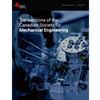成分和微观结构对MS钢筋锈蚀的影响及其对力学性能的影响
IF 1
4区 工程技术
Q4 ENGINEERING, MECHANICAL
Transactions of The Canadian Society for Mechanical Engineering
Pub Date : 2022-04-29
DOI:10.1139/tcsme-2021-0207
引用次数: 1
摘要
钢筋用于钢筋以帮助混凝土,因为混凝土不能承受张力。热机械处理(TMT)是一种先进的钢筋生产技术,但当地钢铁行业出现了锈蚀问题。原材料取样包括铸锭(IC)和连铸(CC)。IC样品的腐蚀频率高于CC样品。光谱分析表明,集成电路样品中铬含量低,锰硫比不合适。IC样品中锰与硫的比例不当会促进晶界的热裂,从而导致晶间腐蚀。G40(风冷)和G60(水冷)的显微组织结果显示,铁素体和马氏体的比例不同。G60中变形的铁素体表明有腐蚀倾向,没有发现合适的稳定马氏体层。马氏体的百分比不足以报复晶间腐蚀。高压水引起的点蚀是由于表面形成小坑。拉伸试验显示,腐蚀样品的极限强度降低了10%,屈服强度降低了8%,伸长率降低了30%。环境研究表明,工业的湿度水平高于实验室空间。Sox和Nox排放的高值表明环境参与了产品表面的劣化。本文章由计算机程序翻译,如有差异,请以英文原文为准。
Effect of composition and microstructure on the rusting of MS Rebars and ultimately their impact on mechanical behavior
Rebar steel is used for reinforcement to aid concrete because concrete does not sustained tension. Thermo-mechanical treatment (TMT) is an advanced manufacturing technique for rebar production but rusting problems emerged at local steel industry. Raw material sampling included ingot casting (IC) & continuous casting (CC). IC samples corroded more frequently than CC samples. Spectroscopy indicated small chromium and improper ratio of manganese to sulphur in IC samples. Improper ratio of manganese to sulphur in IC samples promoted hot cracking at grain boundaries, which results in intergranular corrosion. The microstructural results of G40 (air cooled) and G60 (water cooled) shown ferrite and martensite in different proportion. The deformed ferrite in G60 indicates inclination to corrosion and no proper stable layer of martensite was found. Percentage of martensite was not enough to retaliate intergranular corrosion. Highly pressurized water initiated pitting corrosion due formation of small pits on surface. Tensile testing revealed 10% reduction in ultimate strength, 8% reduction in yield strength and 30% reduction in percent elongation of corroded samples. The environmental study revealed that humidity level of industry was greater than the laboratory space. High values of Sox and Nox emission telltale the involvement of environment in deterioration of product surface.
求助全文
通过发布文献求助,成功后即可免费获取论文全文。
去求助
来源期刊
CiteScore
2.30
自引率
0.00%
发文量
53
审稿时长
5 months
期刊介绍:
Published since 1972, Transactions of the Canadian Society for Mechanical Engineering is a quarterly journal that publishes comprehensive research articles and notes in the broad field of mechanical engineering. New advances in energy systems, biomechanics, engineering analysis and design, environmental engineering, materials technology, advanced manufacturing, mechatronics, MEMS, nanotechnology, thermo-fluids engineering, and transportation systems are featured.

 求助内容:
求助内容: 应助结果提醒方式:
应助结果提醒方式:


